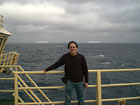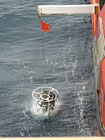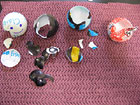Journals 2007/2008
Mark Goldner
Heath School, Brookine, MA
"Dynamics and Transport of the Antarctic Circumpolar Current in Drake Passage"
R/V Nathaniel B. Palmer
November 7 - December 7, 2007 |
 |
 |
Journal Index:
November 7 - 8 - 14 - 15 - 16 - 18 - 19
21 - 22 - 24 - 25 - 27 - 28 - 29
December 2 - 4 - 5 - 6
Additional Resources
|
November 25, 2007
Life in 4,000 meters of water
58° 30' S 62° 45' W
Temp. 2.0°C / Windchill -11.0°C
We are very slowly making our way back North. After modifying the "CTD cast" so it was not as risky to send it down with large swells, the oceanographers went back into action yesterday. The way back will be much slower than the way down, as we need to stop at every CPIES site to (a) communicate with the CPIES device and (b) do a CTD cast as a way to calibrate the CPIES instrument.
Doing so many CTD casts presents a fun opportunity for me to test out some of the ideas from my 7th graders. They were interested in seeing what happens to Styrofoam cups and ping-pong balls when subjected to the enormous pressures at 4,000 meters (over 12,000 feet, or about 2.5 miles down!). And, my daughter Leah and her friend Peyton sent a Barbie doll with me to see what would happen to poor Barbie at that depth. We attached a mesh bag to the CTD apparatus to hold the objects we were testing.
The results are in, and, well...
More great questions from the 7th grade! Keep 'em coming!
Kaitlyn: What was it like to throw the instruments overboard?
Exciting!
What are the instruments like?
Most of what I've been involved in is deploying the CPIES instruments. As you can see from the picture, they are a strange shape. Actually, the white plastic is just a cover for a glass sphere that houses some electronics (and batteries) that drive a sound making device called a transducer. If you look at the blog post from Nov. 19, I go into more detail about the purpose of the CPIES and how they work.
Kaitlyn: What is the best and most fun thing you have done on the ship?
I would have to say standing out on the top deck looking over Antarctica was both beautiful and thrilling. Beautiful because we got to see icebergs and glacier-covered mountains, which I've never really seen before. The colors and shapes were breathtaking. It was also thrilling to see them from the top of a ship that was moving through ice-cold water with the wind blowing.
Jack: Is it very cold down there?
It's pretty cold down here. The temperature is usually a few degrees below 0 degrees C (probably mid-20's to low 30's Farenheit). But the wind is usually very strong, so the wind chill factor makes it feel much much colder.
Jack: Is the water on the ship from the ocean? Do you ever get wet? How big are the waves? Do the water or waves affect your work?
This ship is designed to ride very low in the water - that's part of what makes it stable. Unfortunately it means that when we're working off the back deck, we often take on water, even in relatively calm seas. Sometimes we get some larger waves that crash over the side of the ship. Then we get wet! If it's too rough, then we can't do what we need to do. For example, we've had some very rough seas for the past few days. In fact, we had swells probably over 18 feet yesterday! At this point in the cruise, the oceanographers are sending down something called a "CTD cast", which is a package of equipment that help test the water at different depths. If the seas are too rough, doing a CTD cast can risk damaging the equipment. At first, the scientists decided to wait until the seas calmed down to begin those measurements. Since the seas weren't calming down, they decided had to modify the equipment so it was safer to do.
Jack: Does the boat rock back and forth?
You bet! Last night I was awakened several times as I got banged against the wall. It's also a challenge to work, eat, take a shower, etc. when the boat is rocking so much.
Claire B., Eli, Karny, Jake and Jack: What animals are out there? Do you ever come close to these animals?
We see a trail of birds constantly following us. Mostly we sea a type of bird called "Cape Petrels" and a variety of other species of Petrels and Albatrosses. It's amazing to see so many birds following us so far from land. We've also seen a few whales spouting and breaching off to the distance. Yesterday we had a call from the captain that he had seen some penguins swimming. By the time I got up to the bridge to look, they were gone.
Phoebe and Uma: How long is the ship? How long do you work? Do you have to get up really early to work?
The ship is about 300 feet long. That may seem long, but once you've spent time confined to a boat for over two weeks, it begins to feel small! We work in 12-hour shifts, but there's a lot of down time. I have time to eat meals, talk to people, even play games at times. Since my shift is noon to midnight, I often go to bed after 1 am and sleep until 9 or so. That's quite a change for someone who is used to getting up at 5!
Claire B. and Karny: Why are you wearing a huge suit? What does it do?
I assume you're asking about the "gumby suit", which is a floatation suit that we are issued in case of an emergency. That suit would keep us warm and floating in case the ship needed to be evacuated.
Claire and Uma: Why were you wearing those huge red whale/firefighter suits?
The "firefighter" suits are actually "float coats" which we are required to wear when we are working outside. If we were to go overboard, they would keep us floating.
Uma: Where do you put the ship when you go off?
Well... we haven't gotten off the ship since November 13! Since that day, everything you read from me is from on board the ship. We return to Chile on December 7, where we'll be tied up to a dock.
Josh: Why are there penguins in Chile? Is this the penguin's natural habitat?
I'm not an expert on penguins, but what I understand is that penguins evolved from birds that were isolated on Antarctica when the continent of Antarctica broke away from South America many millions of years ago. What we know as Antarctica used to be connected to South America and Africa, and was much warmer then. As the continent got colder, the birds adapted to life in such a harsh location.
Questions about the statue and me kissing the toe, from Marisa, Roy, Jake, Jhoan, ! Here's the gist of the story:
The first part of our cruise took us up the Strait of Magellan. This is the waterway that passes between mainland South America and a large island known as Tiera del Fuego. The Strait, was named after the Portuguese explorer Hernando de Magellan, who discovered this waterway. (He then went on to be the first European to discover the Pacific Ocean.) In the center of Punta Arenas is a statue of this famous explorer. Tradition holds that travelers who sail across the Drake Passage should kiss the big toe of one of the statues on the monument as good luck. Safe return to Punta Arenas is then assured. Well, I stood in for the science team and did my good luck duty.
Jhoan, Bianna and Jake: Did you guys throw all the instruments? How much information have you collected?
We've kept several instruments on board in case we find that some of the CPIES instruments are malfunctioning. The oceanographers are not eager to take the extras back to Rhode Island, so if we get to the end of the cruise and there are still CPIES left on board (and there is time), we may deploy some extras. It's too early to tell very much from the CPIES right now (they'll be collecting data for 5 years!), but we are getting interesting data from two other sources:
1. As we move along, we are constantly mapping the sea floor using a process called "multi-beam sonar". I've actually been helping to do some of the work on that. Everywhere we go, we are getting accurate data about the depth of the sea floor. This is used to create a little map of the sea floor directly underneath us.
2. We are also collecting data on the ocean currents using a device called an ADCP (Acoustic Doppler Current Profiler). This device measures the direction and speed of the ocean current directly beneath the boat. It uses sound waves, and the Doppler effect as the sound waves bounce off tiny objects in the ocean (like plankton, fish, etc.), to measure the speed and direction of the ocean current. This information is useful for the oceanographers as they map what is happening to the ocean currents over time. If you go to this website (http://currents.soest.hawaii.edu/uhdas_fromships/nbpalmer/figs/) you can link to some of the data we are collecting from the ADCP. On the website you will see "vector plots" and "contour plots". Vector plots show the speed and direction of the ocean current as the Palmer moves along - by tracing a path through the arrows, you are tracing the path we move through (you'll see latitude and longitude grid lines there). Contour plots show the strength and direction of the current as it changes over time and as we change our position.
Metin, Jake: How cold is it in Antarctica? Is it very snowy and does it blizzard?
It can be extremely cold in Antarctica; the average temperature is well below 0 degrees. Since we're just North of Antarctica, it hasn't been too bad. Mostly it's been in the 20's and 30's. We had one day where it was really snowing hard for a few hours. Not like a blizzard, but steady snowfall.
Claire B.: Is the boat comfortable?
It's comfortable enough, but I suppose comfortable is a relative term! Some people absolutely love it on board the ship, and in fact many of the people on this ship spend many months a year at sea. As ships go, this is probably one of the more comfortable ones. I think for me personally it would take a lot for me to get used to being on a ship 24/7. I'm getting better used to the constant back-and-forth and side-to-side motion, but I will enjoy being back on solid land!
Claire B.: What do you eat?
The food is quite good on board (despite our joking about the Thanksgiving soup in a previous post!). For breakfast there is usually eggs, bacon, sometimes French toast or pancakes. For lunch and dinner there is always a hot meat or chicken dish (usually more than one), several vegetable options and rice and beans. There's always a small salad bar as well. There are also desserts - cakes, cookies, etc. If it's someone's birthday then the cooks make a birthday cake. There is also a 4th meal served around midnight at which they serve both some breakfast options as well as some dinner options. (This is important since some people on the midnight-to-noon shift are just waking up.) Tonight we had chicken parmesan or roast beef, mashed potatoes, cooked corn, cooked carrots and veggies, rice and beans.
Claire B.: What science are you an expert in?
Well, here on the ship I'm really more of a learner than an expert! But I was chosen for this particular trip because I have studied physics and engineering in college. Although these scientists are oceanographers, they are interested in what we call the "physics" of the ocean. In particular, they are studying how the ocean moves and how energy is passed around from the wind to the water and between different bodies of water. Although I haven't studied much oceanography, I have enough background in physics to understand what they are doing.
Jordan: Are you homesick?
No, but I am realizing that it's not easy to be away from your family for such a long time, especially when I can't communicate with them every day. I have a new respect for those who choose to spend their lives on board ships away from their families. I'm not sure I would be able to do this again for a long time!
 |
Me, standing on the top deck overlooking a couple of icebergs. I didn't last long out there without my jacket! |
|







